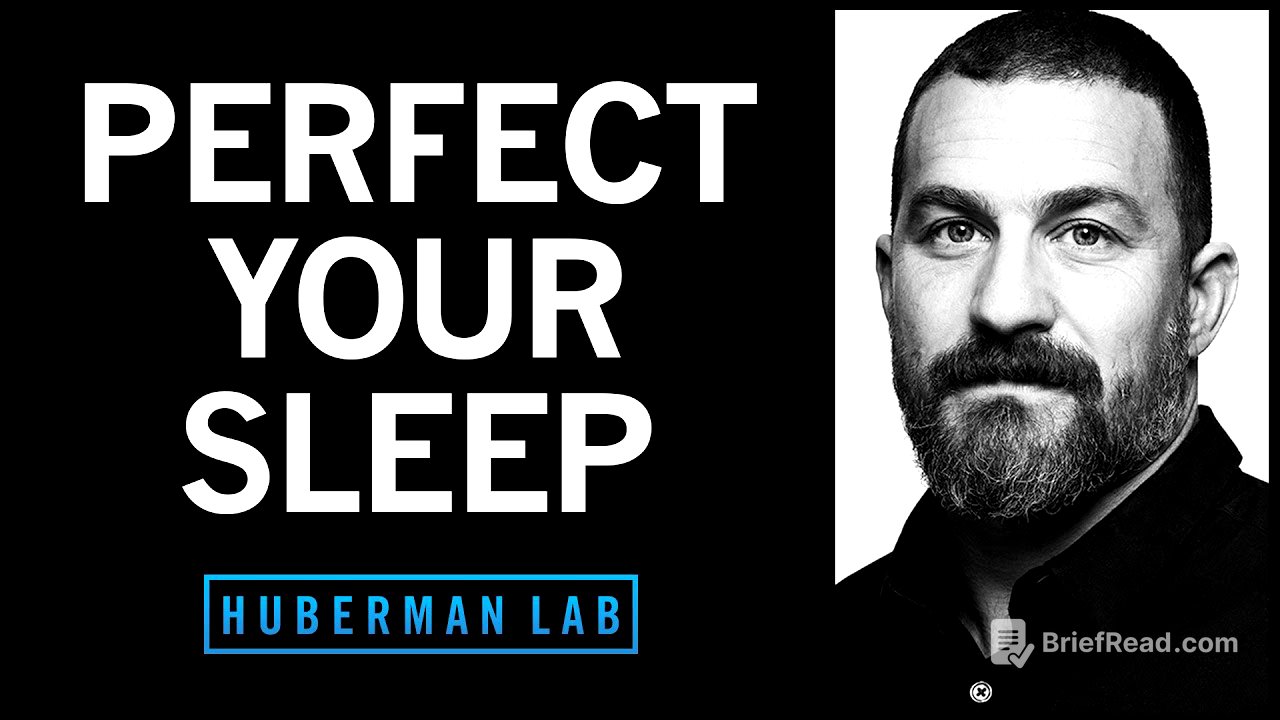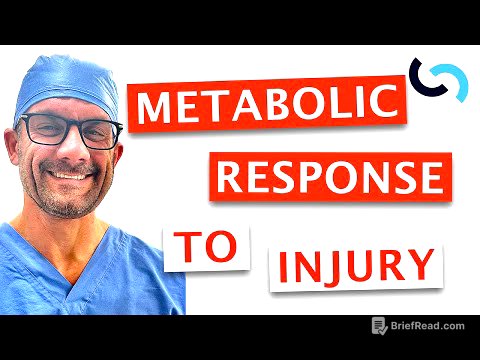TLDR;
This episode of the Huberman Lab Podcast provides a comprehensive toolkit for optimizing sleep, emphasizing that quality sleep is foundational for mental and physical health. It covers various science-backed tools and protocols related to light exposure, temperature regulation, diet, exercise, caffeine intake, supplements, and digital tools. The episode highlights the importance of aligning these tools with three critical periods throughout the day to enhance both sleep and wakefulness.
- Light exposure, especially morning sunlight, is crucial for setting the circadian rhythm.
- Temperature regulation, such as cooling the sleeping environment, aids in falling and staying asleep.
- Strategic use of caffeine, delaying intake after waking, can improve alertness and avoid afternoon crashes.
- Supplements like magnesium threonate, apigenin, and theanine can enhance sleep quality.
- Digital tools like NSDR and self-hypnosis apps can promote relaxation and improve sleep.
Tools to Optimize Sleep [0:00]
The episode introduces sleep optimization as a critical element for overall health, impacting mental and physical well-being, cognitive and physical performance, the immune system, and even longevity. It builds upon previous discussions, incorporating new scientific findings and addressing listener questions about specific protocols for sleep, jet lag, and shift work. The focus is on providing practical tools applicable to various sleep needs, emphasizing that improved sleep enhances focus, energy, and mood.
Momentous Supplements [3:02]
The Huberman Lab Podcast has partnered with Momentous Supplements due to their international shipping, high-quality supplements, and single-ingredient options. The partnership emphasizes providing supplements that allow for systematic and scientific protocol building, optimized for cost and effectiveness. Single-ingredient supplements enable users to adjust dosages and tailor their supplement kit to specific needs.
InsideTracker, Eight Sleep, LMNT [4:16]
The podcast is sponsored by InsideTracker, a personalized nutrition platform that analyzes blood and DNA data to meet health goals. Regular blood work is essential for assessing factors impacting health, and InsideTracker simplifies this by providing a platform with personalized insights and recommendations for nutrition, exercise, and supplementation. Eight Sleep, another sponsor, offers smart mattress covers with cooling, heating, and sleep tracking capabilities, which are closely related to body temperature and sleep quality. LMNT, an electrolyte drink, is also a sponsor, providing essential electrolytes without sugar, crucial for neuron function and overall bodily functions.
Factors to Control Circadian Rhythm & Sleep [8:24]
The episode discusses how to control wakefulness and sleep by understanding the limited entry points to the nervous system. Light (sunlight or artificial), darkness, temperature, food (what, when, and how much), exercise, and caffeine are key tools. Supplements and digital tools like NSDR scripts and self-hypnosis are also important. These tools provide cues to the brain and body, influencing alertness and sleep.
Morning Tool: Morning Sunlight Viewing, Cortisol [15:10]
The ideal 24-hour cycle starts with waking up and experiencing a natural increase in body temperature, triggering cortisol release, which enhances the immune system, metabolism, and focus. Viewing bright light, ideally sunlight, within 30 to 60 minutes of waking is crucial to ensure this cortisol peak occurs early in the day. This practice sets the wake-up signal and starts a timer for sleep later that night.
Morning Sunlight: Circadian Rhythm, Artificial Lights, Cloudy Days [20:44]
Morning sunlight viewing is a foundational tool for sleep and wakefulness, supported by extensive research. If waking before sunrise, use artificial lights but prioritize sunlight once it's out. On cloudy days, increase sunlight exposure. Aim for about five minutes on clear days, 10 minutes on partly cloudy days, and 20-30 minutes on overcast days. Avoid sunlight exposure through windshields or windows. Sunlight simulators can be used when natural light is unavailable.
Evaluating Light in Environment, Compensating for Missed Morning Light [26:18]
To measure light in your environment, use a free app like Light Meter to assess lux levels. Indoor lights are typically around 1,000 lux, while sunlight can range from 5,000 to 90,000 lux. If you miss a day of sunlight exposure, compensate by doubling the duration the following day.
AG1 (Athletic Greens) [29:26]
Athletic Greens (AG1) is highlighted as a comprehensive supplement containing vitamins, minerals, probiotics, digestive enzymes, and adaptogens. It supports the gut-brain axis, which is crucial for mood, immune function, and hormone regulation. AG1 is recommended as a foundational supplement to cover nutritional bases.
Morning Tools: Temperature & Deliberate Cold Exposure, Exercise [30:46]
Leverage temperature as a tool by increasing core body temperature through cold water exposure (1-3 minute cold shower or ice bath) or exercise. Cold water increases adrenaline, dopamine, and core body temperature. Exercise, whether a full workout or light movement, also raises core body temperature, promoting alertness.
Timing Caffeine, “Afternoon Crash,” Exercise [34:58]
Delay caffeine intake for 90-120 minutes after waking to avoid the afternoon crash by allowing residual adenosine to clear. Limit caffeine after 4:00 p.m. to avoid disrupting sleep architecture. If exercising in the morning, caffeine before the workout is acceptable but may cause an earlier energy dip.
Timing Eating, Alertness & Circadian Rhythm [40:08]
Eating early in the day supports a biological clock mechanism that increases alertness. While intermittent fasting is common, eating early can enhance metabolism and temperature, layering with other tools like sunlight and exercise. Be mindful of food volume, as large meals can cause sleepiness.
3 Daily Critical Periods [45:20]
There are three critical periods in a 24-hour cycle: the first three hours after waking, the afternoon into evening, and from 5:00 p.m. until bedtime. Each period requires specific tools to optimize wakefulness, focus, mood, and sleep.
Afternoons: Naps, Deep Relaxation (NSDR, Self-Hypnosis), Exercise & Body Temperature, Caffeine [46:49]
In the afternoon, limit caffeine intake and consider naps, but avoid napping too late or too long to prevent disrupting nighttime sleep. Naps should be shorter than 90 minutes. Non-sleep deep rest (NSDR) scripts, self-hypnosis, or yoga nidra can be beneficial. Be mindful of the clock-delaying effects of intense exercise and avoid excessive caffeine.
Afternoon Tools: Viewing Sunlight in Late Afternoon, Evening Light [51:59]
Get sunlight in the late afternoon and evening to protect against the negative effects of artificial light at night. This practice signals to the circadian clock that evening is approaching and establishes a second reference point for the brain and body. The changing ratios of yellows, blues, and oranges in evening sunsets signal the time of day.
Evening/Night Tools: Overhead Artificial Lights, Light Sensitivity [56:45]
In the evening, avoid bright artificial lights of all colors, especially overhead lights, between 10:00 p.m. and 4:00 a.m. Use dim lights low in the environment, such as desk lamps or candlelight. Viewing afternoon sunlight can offset some negative effects of artificial light at night.
Evening Tools: Hot Bath/Sauna, Temperature & Sleeping Environment [1:04:40]
Take a hot bath or sauna in the evening to facilitate a compensatory cooling off of the core body temperature. Maintain a cool sleeping environment, dropping the temperature by at least three degrees, and use blankets as needed. Avoid wearing socks to allow heat to escape through glabrous skin on the palms and feet.
Alcohol, THC & Reduced Sleep Quality; CBD, Anxiety & Falling Asleep [1:09:40]
Avoid alcohol and THC, as they disrupt sleep architecture despite helping some people fall asleep. While CBD and THC may lower anxiety and aid sleep, they still compromise sleep quality.
Sleep Supplements: Magnesium Threonate, Apigenin & Theanine [1:11:45]
Consider supplements like magnesium threonate (145mg), apigenin (50mg), and theanine (100-400mg) 30-60 minutes before bedtime to improve sleep. These supplements have wide margins of safety, but consult with a physician before starting. Adjust dosages based on individual needs and tolerances.
Melatonin Supplementation (Caution) [1:16:34]
Avoid chronic melatonin supplementation due to supraphysiological dosages that can disrupt hormone systems. Other supplements are preferable.
Additional Sleep Supplements: GABA, Glycine, Myo-Inositol & Anxiety [1:17:44]
Consider glycine (2g) and GABA (100mg) every third or fourth night to enhance sleep. Myo-inositol (900mg) can improve the ability to fall back asleep and reduce daytime anxiety.
Falling Back Asleep: Reveri App, NSDR, Yoga Nidra [1:20:08]
Use NSDR, the Reveri app, or yoga nidra to fall back asleep. The Reveri app, developed with research-backed hypnosis techniques, offers a structured approach, while NSDR and yoga nidra provide zero-cost alternatives.
Staying Asleep: Eye Masks, Ear Plugs, Elevating Feet [1:22:55]
Use eye masks to block light, ensuring the sleeping environment is cool to prevent overheating. Earplugs can be beneficial for some but may cause disruptive humming for others. Elevating feet can increase sleep depth by improving glymphatic washout, but avoid this if you have acid reflux.
Tool: Sleep Apnea & Nasal Breathing [1:24:58]
Address sleep apnea by training yourself to breathe through your nose during sleep. Use medical tape to keep your mouth shut and practice nasal breathing during cardiovascular exercise to dilate sinuses.
Sleep Schedule Consistency, Weekends, Compensatory Sleep & Caffeine [1:28:20]
Maintain consistent sleep and wake times, even on weekends, to enhance sleep quality. If staying out late, limit sleeping in to an hour beyond your normal wake-up time. Delay caffeine intake 90-120 minutes after waking, especially after a night of poor sleep, and use NSDR to compensate.
Tools: Temperature Minimum & Jet Lag, Shift Work & Red Lights [1:31:14]
Understand your temperature minimum (approximately two hours before your typical wake-up time) to adjust your schedule. Viewing bright light, exercising, or drinking caffeine before your temperature minimum will delay your clock, while doing these activities after your temperature minimum will advance your clock. For shift work, try to maintain the same shift for at least two weeks. Use red light if you need to be awake during your sleep cycle to minimize disruption of the cortisol rhythm.
Behavioral Tools for 3 Daily Critical Periods [1:37:38]
Prioritize behavioral tools related to light, temperature, food, and exercise, aligning them with the three critical periods throughout the day. These tools are supported by research and can significantly improve sleep quality and daytime alertness.
Zero-Cost Support, YouTube Feedback, Huberman Lab Clips, Spotify & Apple Reviews, Sponsors, Momentous Supplements, Instagram, Twitter, Neural Network Newsletter [1:39:26]
Support the podcast by subscribing to the YouTube channel and clips channel, leaving reviews on Spotify and Apple, and checking out the sponsors. Access protocols and summaries through the Neural Network Newsletter at hubermanlab.com. Follow @hubermanlab on Instagram and Twitter for additional science-related tools and information.









